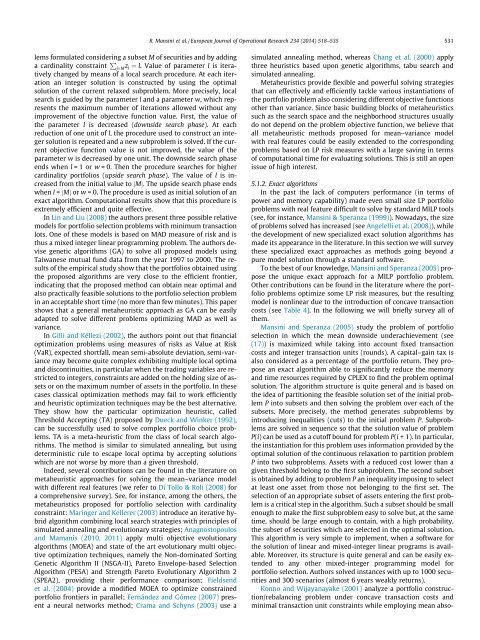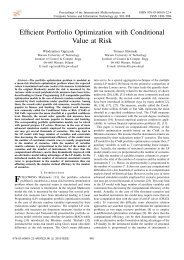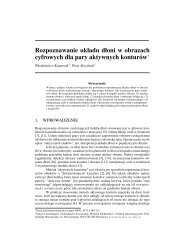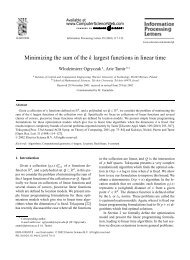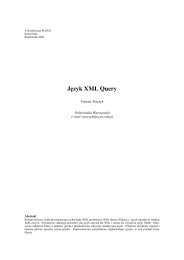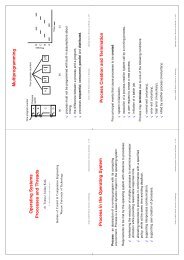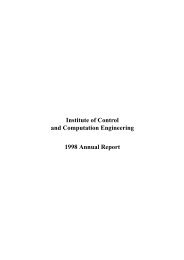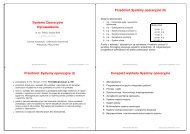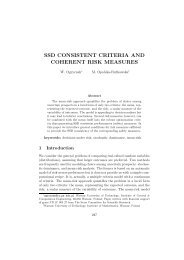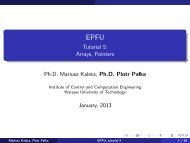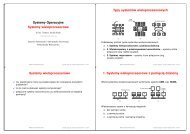Twenty Years of Linear Programming Based Portfolio Optimization
Twenty Years of Linear Programming Based Portfolio Optimization
Twenty Years of Linear Programming Based Portfolio Optimization
You also want an ePaper? Increase the reach of your titles
YUMPU automatically turns print PDFs into web optimized ePapers that Google loves.
R. Mansini et al. / European Journal <strong>of</strong> Operational Research 234 (2014) 518–535 531<br />
lems formulated considering a subset M <strong>of</strong> securities and by adding<br />
a cardinality constraint P j2M z j ¼ l. Value <strong>of</strong> parameter l is iteratively<br />
changed by means <strong>of</strong> a local search procedure. At each iteration<br />
an integer solution is constructed by using the optimal<br />
solution <strong>of</strong> the current relaxed subproblem. More precisely, local<br />
search is guided by the parameter l and a parameter w, which represents<br />
the maximum number <strong>of</strong> iterations allowed without any<br />
improvement <strong>of</strong> the objective function value. First, the value <strong>of</strong><br />
the parameter l is decreased (downside search phase). At each<br />
reduction <strong>of</strong> one unit <strong>of</strong> l, the procedure used to construct an integer<br />
solution is repeated and a new subproblem is solved. If the current<br />
objective function value is not improved, the value <strong>of</strong> the<br />
parameter w is decreased by one unit. The downside search phase<br />
ends when l =1 or w = 0. Then the procedure searches for higher<br />
cardinality portfolios (upside search phase). The value <strong>of</strong> l is increased<br />
from the initial value to jMj. The upside search phase ends<br />
when l = jMj or w = 0. The procedure is used as initial solution <strong>of</strong> an<br />
exact algorithm. Computational results show that this procedure is<br />
extremely efficient and quite effective.<br />
In Lin and Liu (2008) the authors present three possible relative<br />
models for portfolio selection problems with minimum transaction<br />
lots. One <strong>of</strong> these models is based on MAD measure <strong>of</strong> risk and is<br />
thus a mixed integer linear programming problem. The authors devise<br />
genetic algorithms (GA) to solve all proposed models using<br />
Taiwanese mutual fund data from the year 1997 to 2000. The results<br />
<strong>of</strong> the empirical study show that the portfolios obtained using<br />
the proposed algorithms are very close to the efficient frontier,<br />
indicating that the proposed method can obtain near optimal and<br />
also practically feasible solutions to the portfolio selection problem<br />
in an acceptable short time (no more than few minutes). This paper<br />
shows that a general metaheuristic approach as GA can be easily<br />
adapted to solve different problems optimizing MAD as well as<br />
variance.<br />
In Gilli and Këllezi (2002), the authors point out that financial<br />
optimization problems using measures <strong>of</strong> risks as Value at Risk<br />
(VaR), expected shortfall, mean semi-absolute deviation, semi-variance<br />
may become quite complex exhibiting multiple local optima<br />
and discontinuities, in particular when the trading variables are restricted<br />
to integers, constraints are added on the holding size <strong>of</strong> assets<br />
or on the maximum number <strong>of</strong> assets in the portfolio. In these<br />
cases classical optimization methods may fail to work efficiently<br />
and heuristic optimization techniques may be the best alternative.<br />
They show how the particular optimization heuristic, called<br />
Threshold Accepting (TA) proposed by Dueck and Winker (1992),<br />
can be successfully used to solve complex portfolio choice problems.<br />
TA is a meta-heuristic from the class <strong>of</strong> local search algorithms.<br />
The method is similar to simulated annealing, but using<br />
deterministic rule to escape local optima by accepting solutions<br />
which are not worse by more than a given threshold.<br />
Indeed, several contributions can be found in the literature on<br />
metaheuristic approaches for solving the mean–variance model<br />
with different real features (we refer to Di Tollo & Roli (2008) for<br />
a comprehensive survey). See, for instance, among the others, the<br />
metaheuristics proposed for portfolio selection with cardinality<br />
constraint: Maringer and Kellerer (2003) introduce an iterative hybrid<br />
algorithm combining local search strategies with principles <strong>of</strong><br />
simulated annealing and evolutionary strategies; Anagnostopoulos<br />
and Mamanis (2010, 2011) apply multi objective evolutionary<br />
algorithms (MOEA) and state <strong>of</strong> the art evolutionary multi objective<br />
optimization techniques, namely the Non-dominated Sorting<br />
Genetic Algorithm II (NSGA-II), Pareto Envelope-based Selection<br />
Algorithm (PESA) and Strength Pareto Evolutionary Algorithm 2<br />
(SPEA2), providing their performance comparison; Fieldsend<br />
et al. (2004) provide a modified MOEA to optimize constrained<br />
portfolio frontiers in parallel; Fernández and Gómez (2007) present<br />
a neural networks method; Crama and Schyns (2003) use a<br />
simulated annealing method, whereas Chang et al. (2000) apply<br />
three heuristics based upon genetic algorithms, tabu search and<br />
simulated annealing.<br />
Metaheuristics provide flexible and powerful solving strategies<br />
that can effectively and efficiently tackle various instantiations <strong>of</strong><br />
the portfolio problem also considering different objective functions<br />
other than variance. Since basic building blocks <strong>of</strong> metaheuristics<br />
such as the search space and the neighborhood structures usually<br />
do not depend on the problem objective function, we believe that<br />
all metaheuristic methods proposed for mean–variance model<br />
with real features could be easily extended to the corresponding<br />
problems based on LP risk measures with a large saving in terms<br />
<strong>of</strong> computational time for evaluating solutions. This is still an open<br />
issue <strong>of</strong> high interest.<br />
5.1.2. Exact algorithms<br />
In the past the lack <strong>of</strong> computers performance (in terms <strong>of</strong><br />
power and memory capability) made even small size LP portfolio<br />
problems with real feature difficult to solve by standard MILP tools<br />
(see, for instance, Mansini & Speranza (1999)). Nowadays, the size<br />
<strong>of</strong> problems solved has increased (see Angelelli et al. (2008)), while<br />
the development <strong>of</strong> new specialized exact solution algorithms has<br />
made its appearance in the literature. In this section we will survey<br />
these specialized exact approaches as methods going beyond a<br />
pure model solution through a standard s<strong>of</strong>tware.<br />
To the best <strong>of</strong> our knowledge, Mansini and Speranza (2005) propose<br />
the unique exact approach for a MILP portfolio problem.<br />
Other contributions can be found in the literature where the portfolio<br />
problems optimize some LP risk measures, but the resulting<br />
model is nonlinear due to the introduction <strong>of</strong> concave transaction<br />
costs (see Table 4). In the following we will briefly survey all <strong>of</strong><br />
them.<br />
Mansini and Speranza (2005) study the problem <strong>of</strong> portfolio<br />
selection in which the mean downside underachievement (see<br />
(17)) is maximized while taking into account fixed transaction<br />
costs and integer transaction units (rounds). A capital–gain tax is<br />
also considered as a percentage <strong>of</strong> the portfolio return. They propose<br />
an exact algorithm able to significantly reduce the memory<br />
and time resources required by CPLEX to find the problem optimal<br />
solution. The algorithm structure is quite general and is based on<br />
the idea <strong>of</strong> partitioning the feasible solution set <strong>of</strong> the initial problem<br />
P into subsets and then solving the problem over each <strong>of</strong> the<br />
subsets. More precisely, the method generates subproblems by<br />
introducing inequalities (cuts) to the initial problem P. Subproblems<br />
are solved in sequence so that the solution value <strong>of</strong> problem<br />
P(i) can be used as a cut<strong>of</strong>f bound for problem P(i + 1). In particular,<br />
the instantiation for this problem uses information provided by the<br />
optimal solution <strong>of</strong> the continuous relaxation to partition problem<br />
P into two subproblems. Assets with a reduced cost lower than a<br />
given threshold belong to the first subproblem. The second subset<br />
is obtained by adding to problem P an inequality imposing to select<br />
at least one asset from those not belonging to the first set. The<br />
selection <strong>of</strong> an appropriate subset <strong>of</strong> assets entering the first problem<br />
is a critical step in the algorithm. Such a subset should be small<br />
enough to make the first subproblem easy to solve but, at the same<br />
time, should be large enough to contain, with a high probability,<br />
the subset <strong>of</strong> securities which are selected in the optimal solution.<br />
This algorithm is very simple to implement, when a s<strong>of</strong>tware for<br />
the solution <strong>of</strong> linear and mixed-integer linear programs is available.<br />
Moreover, its structure is quite general and can be easily extended<br />
to any other mixed-integer programming model for<br />
portfolio selection. Authors solved instances with up to 1000 securities<br />
and 300 scenarios (almost 6 years weakly returns).<br />
Konno and Wijayanayake (2001) analyze a portfolio construction/rebalancing<br />
problem under concave transaction costs and<br />
minimal transaction unit constraints while employing mean abso-


